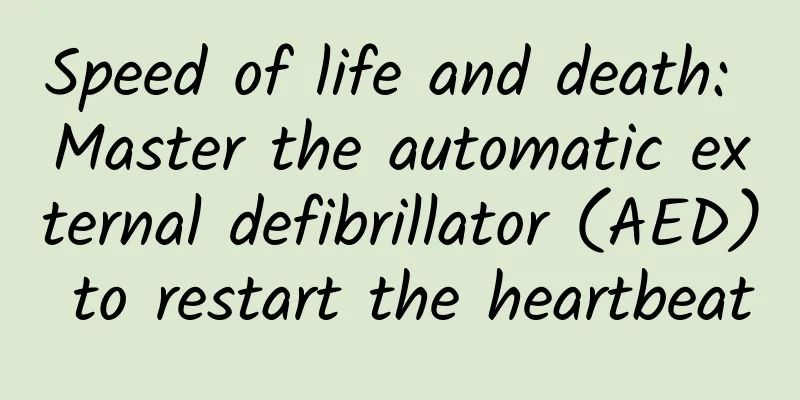Speed of life and death: Master the automatic external defibrillator (AED) to restart the heartbeat

|
Author: Yu Feifei, attending physician of the Chinese People's Liberation Army Navy Special Medical Center Reviewer: Xie Yi, deputy chief physician of the Chinese People's Liberation Army Navy Special Medical Center 1. What is an automated external defibrillator? An Automated External Defibrillator (AED) is a portable, easy-to-use emergency device designed for on-site first aid. It uses a built-in computer to analyze and determine whether the patient needs defibrillation, and automatically provides defibrillation after the judgment. It is known as a "life-saving device" because of its portability, ease of operation, and good effect. Even non-medical professionals can quickly master its use after simple training. 2. Why use an automated external defibrillator? Statistics show that about 550,000 people in my country die of sudden cardiac death each year. The deployment and popularization of AEDs is an effective way to buy precious rescue time for patients and improve the success rate of treatment[1]. In particular, in my country's plateau areas, due to special geographical and climatic conditions such as hypoxia and hypoxia, the risk of diseases such as cardiac arrest is much higher than in plain areas. Therefore, it is particularly important to master the use of AEDs in plateau areas. When encountering sudden cardiac arrest or ventricular fibrillation, the timely use of AEDs can significantly improve the patient's survival rate, especially when defibrillation is performed within the "golden 4 minutes" after cardiac arrest occurs, the patient's survival rate can reach 50%. Therefore, raising public awareness of the importance of AEDs and ensuring that this "life-saving device" can be used quickly, correctly and effectively in emergency situations is crucial to saving lives[2]. Figure 1 Copyright image, no permission to reprint 3. Under what circumstances is it necessary to use an automated external defibrillator? Generally, when a patient suddenly collapses and the carotid artery pulse cannot be felt, that is, when it is judged as cardiac arrest, an AED should be used immediately. Since the AED machine itself has the function of automatically interpreting the electrocardiogram and determining whether an electric shock is needed, the user does not need to worry too much about the timing of use. In particular, some fully automatic models only require the rescuer to attach the electric shock patch to the patient, and the AED can judge and produce the necessary electric shock. 4. How to use an automated external defibrillator? First, quickly unbutton the patient's shirt, clean off sweat and any metal objects on the patient's chest, and ensure that the chest is completely exposed and unobstructed. After the AED equipment is in place, start defibrillation immediately. The entire process must follow the steps of "start, apply, clean, charge, and power": ① start the AED equipment; ② apply coupling agent to the appropriate position of the patient's chest; ③ clear the area to ensure that no one around touches the patient; ④ charge the AED equipment; ⑤ discharge according to the instructions of the AED and perform an external chest shock. While the AED is analyzing the heart rhythm and preparing for shock, the rescuer should continue to perform chest compressions on the patient, maintaining a compression frequency of 100 to 120 times per minute and ensuring that the compression depth is sufficient until the patient's heart rhythm recovers or further medical instructions are received. Figure 2 Copyright image, no permission to reprint 5. What are the precautions when using an automated external defibrillator? When using an AED, special attention should be paid to the following issues to ensure the safety and effectiveness of the operation: 1. Environmental safety: First of all, the rescue environment must be safe to avoid secondary injuries during the first aid process. 2. Patient preparation: Make sure the patient lies on his back on a flat and hard surface with no covering on his chest. If necessary, quickly remove the patient's clothing so that the AED electrodes can fit closely to the skin. 3. Placement of electrodes: Strictly follow the instructions of the AED and stick the electrodes on the correct position of the patient's chest. Usually, one electrode should be placed on the right edge of the sternum, 2 to 3 intercostal spaces below the clavicle, and the other on the junction of the left anterior axillary line and the fifth intercostal space. Generally speaking, one is placed under the clavicle on the upper right chest, and the other is placed on the outside of the left nipple. 4. Avoid contact: When the AED is analyzing heart rhythm and charging, it is necessary to ensure that no one touches the patient to prevent the risk of electric shock. 5. Fix the electrodes: If the electrodes are attached upside down, you do not have to remove them and reattach them immediately, but you must ensure that they fit tightly against the skin to ensure that the current can pass smoothly. 6. Dry conditions: Before use, make sure the patient's chest is dry. If there is moisture or sweat, wipe it off quickly to avoid affecting the effectiveness of the AED. 7. Avoid water and metal: It is strictly forbidden to use AED on the surface of water or conductive objects such as metal to prevent short circuit or electric shock injury. 8. Pacemaker patients: If the patient has a pacemaker, the electrodes should be placed at least 2.5 cm away from the pacemaker to avoid interfering with the normal operation of the pacemaker. 9. Continued cardiopulmonary resuscitation: Cardiopulmonary resuscitation should be performed immediately and continuously during AED analysis and charging, and after shock, to maintain the patient's vital signs [3]. References [1] Cheng Yuanzhou, Dou Hanyang, Wang Zhe. Popularizing AED: How to use it effectively [N]. People's Daily. [2] Cao Juan, Zhang Hui, Jia Jia, et al. Observation on the effect of AED training machine assisted cardiopulmonary resuscitation training in standardized training of anesthesiology residents[J]. Chinese Postgraduate Medical Education, 2024, 8(06): 427-430. [3] Huang Shan. How to use AED to better protect people’s lives and health[N]. Jinhua Daily. |
<<: Precision treatment, protecting the heart
>>: Pay attention to these symptoms, they may be a warning sign of heart disease! Check yourself →
Recommend
What time does Beijing's Nanluoguxiang close at night? What delicious food is there in Beijing's Nanluoguxiang?
Beijing's Nanluoguxiang is an ancient street ...
How to remove mole scars, homemade scar removal mask
Mole removal is the use of some artificial means ...
What is lower abdominal pain?
Women's bodies are prone to problems, especia...
I feel a little nauseous after having sex.
Making love is something that every couple and ev...
How long after giving birth can I use a belly band?
Female friends who have given birth know that aft...
What supplements should girls take during menarche
With the continuous improvement of living standar...
Leukocyte esterase 2 in pregnant women
Key reminder: Many women will find that they have...
What are the treatments for uterine fibroids?
1. Use conservative treatment: Reasonable medicat...
I just finished peeing and I want to pee again
In recent years, we have found that although our ...
The difference between a partial hysterectomy and a total hysterectomy
The uterus is a very important existence for a wo...
Why does leucorrhea look like tofu dregs?
Leucorrhea is a physiological phenomenon that eve...
A 32-year-old man suddenly suffered a heart attack and fell into a coma! Doctors remind you: These bad habits may cost you your life
"Fortunately, he was in the hospital when th...
What is the reason for female urine blood
Blood in urine refers to blood in the urine. It i...
Can Chinese medicine treat premature ovarian failure?
Important reminder: The causes of premature ovari...
It’s perfect to eat like this in summer, it’s delicious and convenient for losing fat, even the people setting up stalls come to learn from you!
In the hot summer, appetite seems to rise along w...









